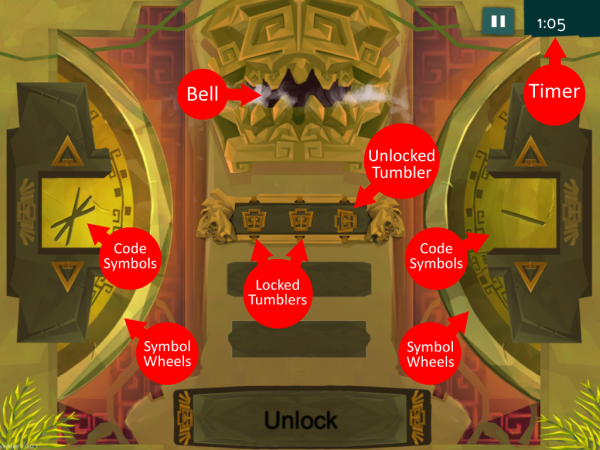

Decode Activity
Using the codes learned and memorized from the Study activity match the symbols on each side of the wheels of the tomb. Each time a code set is successfully matched, a tumbler on a lock is released. Crack all three locks to obtain one of the sacred Campanas de Oro.
With one of the solid gold Bells within the locked tomb, you must decode the locks by properly aligning the symbol pairs on the wheels of the tomb. Each wheel can be turned by dragging a finger along the exposed part of the wheel in that direction. As the wheels rotate, different symbols will become visible through small windows (these symbols are the ones you have previously discovered in the Study Activity). Wheels will have both valid code symbols and distractors. Turn both wheels to find the correct symbol pair and push the Unlock button once you believe you’ve selected the correct pair. Each time a code pair is successfully matched it releases one of three tumblers in the lock. When all three tumblers are cracked, the lock opens and the gate moves, opening the vault. Once all three locks are opened, the game is won and you can recover the Bell. If the time limit expires before the player opens all the locks, the player loses the game.
Rotate Wheel – Drag the wheel up or down to rotate it.
Unlock- Press the Unlock button when you have correctly matched the pairs.
It does not matter in what order symbol pairs are used, as long as they are correctly matched.
The objective of Decode is to input all gathered codes sets and unlock the Bell before time runs out. The Bell, visible behind bars, is locked with a set of three tumblers. The wheels of the tomb have symbols engraved on their side, with both distractors and valid code symbols from the previous Study activities. The player turns the two wheels to match pairs of symbols that have been discovered earlier in Study games. As the wheel spins, different codes become visible in the windows of the walls. When the player believes they have matched the correct symbols, they press the Unlock button. If the two window symbols match correctly, then a tumbler will open, turning from horizontal to vertical.
If the two window symbols do NOT match to form a code, the jaguar head will blow smoke, barring the player from input for a brief moment. Once all of the locks are opened, the game is won and the player recovers the Bell. Recovering a Bell unlocks new areas, progresses the game and rewards the player with points. If the time limit expires before the player correctly matches the three codes, the player loses the game and must try again.
The player may have difficulty with the following:
There are three levels for the Decode activity, depending on what Bell you are unlocking.
| Level | Number of Locks | Total Codes Needed | Code Sets Used | Unique Symbols (Per Wheel) |
| Bell A | 1 | 3 | A | 6 |
| Bell B | 2 | 6 | A+B | 12 |
| Bell C | 3 | 9 | A+B+C | 18 |
This activity is a form of code substitution. Associative memory is classically measured using a code substitution task. Code substitution is typically considered an index of complex scanning, visual tracking and attention when both sets of symbols are visible. This activity requires the player to remember previous pairings.
| Skill | SubDomain | Measurement |
| Executive Functions | Organization |
For all of the times a player pairs two symbols (correct and incorrect), this is the percentage of times they matched the symbols correctly.The higher the number the better the score. This measure of organization is based on Mateer's Model of Executive function and captured from the Decode min-game. |
| Out of all of the symbol pairs on this level, this is the percentage the player matched correctly (locks unlocked) before time ran out. This is a memory strategy score because the player can use strategies such as writing things down or taking pictures to remember which symbols are paired together. The higher the number the better the score. This measure of organization is based on Mateer's Model of Executive function and captured from the Decode min-game. |